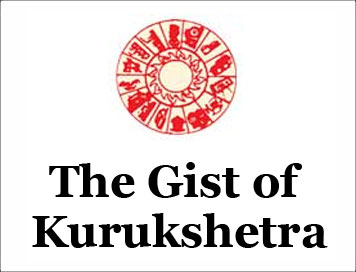(HOT) UPSC Current Affairs 2025 PDF
NEW! The Gist (NOV-2025) | E-BOOKS
(GIST OF KURUKSHETRA) Crop Residue Burning: Challenges and Sustainable Solutions
(GIST OF KURUKSHETRA) Crop Residue Burning: Challenges and Sustainable Solutions
(JUNE-2025)
Crop Residue Burning: Challenges and Sustainable Solutions
Context:
Crop residue burning began in several Asian countries, including India, with the rise of mechanized farming in 1986. Farmers transitioned from manual harvesting, which left roots intact, to burning crop residues as a cost-effective alternative.
- Seasonal Patterns: Rice residues are burnt pre-winter to prepare for wheat cultivation under cooler temperatures, while wheat residues are burnt pre-monsoon. Sugarcane residues are burnt after harvest, typically in the post-monsoon or pre-summer seasons, depending on the regional harvesting schedule.
- Regional Spread: Originated in Punjab and gradually expanded to neighbouring states like Haryana and Uttar Pradesh.
Rising Concerns:
The practice has increased over the years, exacerbating environmental issues, some of which are as follows:
-
Loss of Essential Nutrients: Burning destroys about 80% of critical nutrients like nitrogen, phosphorus, potassium, sulphur, and organic carbon, which could otherwise enrich the soil.
-
Soil Health Damage: Raises soil temperature, kills beneficial organisms, and depletes nitrogen and carbon in the vital 0-15 cm soil layer where crop roots grow.
-
Greenhouse Gas Emissions: Releases significant pollutants, including CH4 CO, N2O, NOx, and hydrocarbons. In the case of rice straw, 70% of the carbon is emitted as CO2, 7% as CO, and 0.66% as CH4, while 2.09% of the nitrogen is released as N2O.
-
Air Pollution: Emits large quantities of particulate matter, containing carcinogenic compounds that contribute to respiratory and other airborne diseases.
Crop Residue Management Options in India
In-situ Management Techniques and Mechanical Tools
-
Mulching: Protects soil from erosion, retains moisture, suppresses weeds, and enriches soil with nutrients. Straw mulchers shred and spread residues to retain moisture and suppress weeds. The Super Straw Management System (Super SMS) chops and spreads stubble during harvesting, simplifying residue handling.
Ex-Situ Management Techniques
-
Biomass Power Generation: Using. residues to produce electricity or heat.
-
Animal Feed: Converting residues into fodder for cattle, sheep, and goats.
-
Composting: Combines residues with organic material so improves oil fertility and structure. Pusa Decomposer accelerates residue breakdown into manure, reducing fertilizer use and improving crop yields for under per acre.
-
Biochar Production: Residues are heated without oxygen to improve soil fertility, water retention, and crop yield.
-
Industrial Uses: Residues are repurposed for paper, textiles, and building materials.
Both in-situ and ex-situ methods minimize environmental harm from burning. They provide natural nutrients, reduce fertilizer dependency, and enhance soil health. The choice depends on crop type, residue quantity, and available processing resources.
Why do farmers opt for crop residue burning?
-
Time Constraints in Rice-Wheat System: The narrow window between rice harvesting in October and wheat planting in November pushes farmers, especially in Punjab and Haryana, to burn crop residues for quick field clearance.
-
No-Till Farming: Planting crops without disturbing the soil, conserving moisture, and reducing erosion. The Happy Seeder enables no-till planting into standing residues, eliminating burning and conserving moisture. Zero-till drills facilitate planting without disturbing the soil, maintaining residue cover.
-
Strip-till farming involves tilling narrow soil strips for seeding while retaining residue cover in other areas. Rotavators mix residues into the soil to improve fertility.
-
Cover Crops: Providing ground cover enriches the soil and can serve as mulch.
-
Crop Rotation: Alternating crops reduces erosion, prevents nutrient depletion, and enhances soil health.
-
High Manual Removal Costs: Manual residue removal costs per acre, making burning a cheaper and faster alternative.
Limited Adoption of Sustainable Technologies:
The Happy Seeder, capable of cutting stubble and sowing wheat simultaneously, is available for Rs. 1,000 rental and Rs. 2,000 diesel per acre. Despite subsidies, tools like Rotavators and Straw Balers remain prohibitively expensive for small and marginal farmers, hindering adoption.
-
Infrastructure Deficits: Insufficient large-scale facilities for collection, storage, and transport of residues prevent their utilization in biomass-based power plants and industries.
-
Financial constraints for Small Farmers: Farmers with less than 2 hectares of land prioritize short-term cost savings and efficiency over long-term environmental benefits due to financial limitation.
Government Interventions to Crop Residue management (CRM)
-
Restructured RKVY (2022-23): The Rashtriya Krishi Vikas Yojana was revamped to include the Sub-Mission on Agriculture Mechanization, providing financial assistance for acquiring CRM equipment and farm machinery.
-
Support from Multiple Programs: The CRM scheme is strengthened by funding from the RKVY, Agriculture Infrastructure Fund (AIF), and various the agricultural extension programs.
-
Custom Hiring Centres (CHCs): Over 40,000 CHCs have been established, distributing more than 295,000 CRM machines to centres and individual farmers, enhancing accessibility.
-
Investment in Biomass Supply Chain: Government funds are allocated to strengthen biomass supply chains and boost capital expenditure for ex-situ industries.
-
ICAR Demonstrations: The Indian Council of Agricultural Research demonstrated crop residue management machinery on 20,000 hectares during 2022-23, emphasizing improved farmer training and capacity building for sustainable practices.
Conclusion:
- By implementing these solutions, we can promote both environmental sustainability and economic growth in agriculture.
CLICK HERE TO DOWNLOAD FULL PDF
CLICK HERE TO DOWNLOAD UPSC E-BOOKS
Study Material for UPSC General Studies Pre Cum Mains
Get The Gist 1 Year Subscription Online
Click Here to Download More Free Sample Material
<<Go Back To Main Page
Courtesy: Kurukshetra



